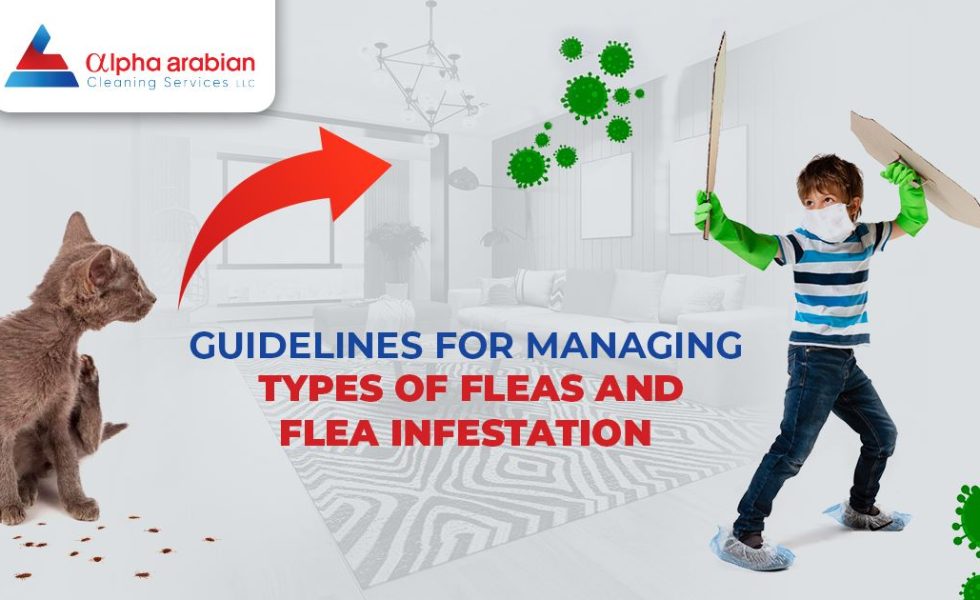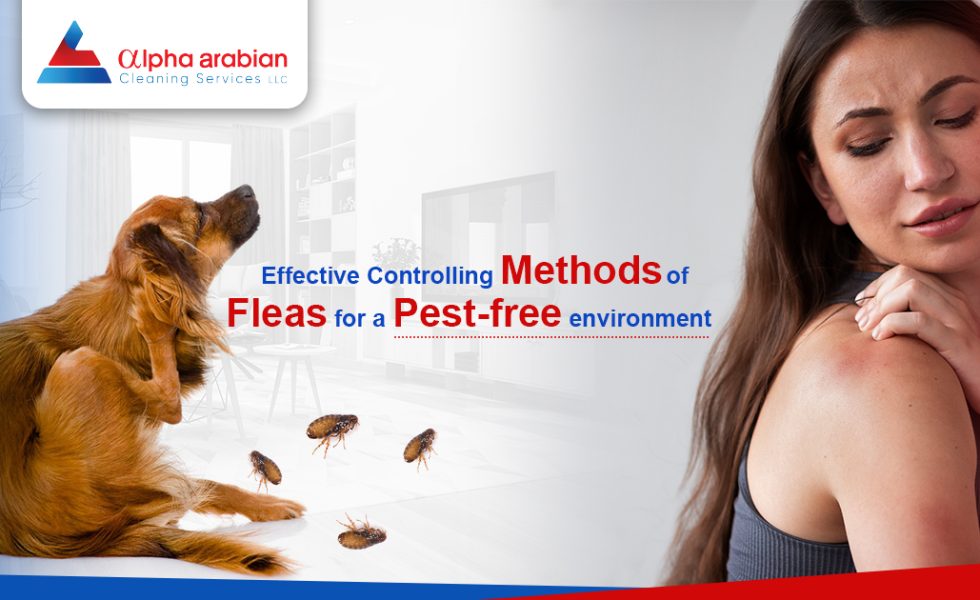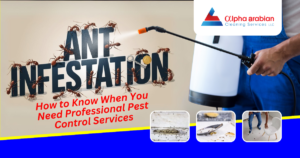Guidelines for managing types of fleas and flea infestation
Fleas, those tiny but troublesome insects, have been pests to both humans and animals for centuries. With their ability to spread diseases and cause skin irritations, fleas have earned a notorious reputation as unwelcome houseguests. There exists a significant risk of these pests taking up residence within a pet’s body, potentially leading to harm for humans as well. Additionally, the presence of fleas within your living space can be attributed to elevated humidity levels and soaring temperatures. The maintenance of these specific conditions requires careful attention. Consequently, effective flea control measures are of utmost importance, particularly in regions like Dubai.
Let’s discuss the different types of fleas, the risks they pose, and effective methods for flea control.
Types of Fleas:
Human Flea (Pulex irritans): The human flea, as the name suggests, primarily targets humans, along with pigs, dogs, and goats. Found almost everywhere around the world, this flea is more common in warmer regions and can cause dermatitis or allergies due to its bites. It also serves as a vector for diseases like plague and typhus.
Rat Fleas (Xenopsylla spp, Nosopsyllus fasciatus): Rat fleas, including species like Xenopsylla cheopsis, Xenopsylla astia, and Nosopsyllus fasciatus, are known for their association with rodents. X. cheopis is a significant vector of the plague, while Nosopsyllus fasciatus is more common in temperate regions. These fleas can spread infections like typhus and plague, making them a serious concern for the safety of public.
Cat Flea (Ctenocephalides felis): One of the most common domestic pests globally, the cat flea feeds on cats, dogs, goats, and even humans. With a stronghold in temperate developed countries, it can transmit diseases such as typhus. Its prevalence and ability to bite multiple hosts make effective flea control crucial.
Dog Flea (Ctenocephalides canis): Less common than its feline counterpart, the dog flea prefers dogs and humans but rarely targets cats. While it might not be as widespread, it still poses a potential risk for disease transmission, including typhus.
Chicken Flea (Ceratophyllus gallinae): Targeting chickens, this flea is a concern in animal production units. While it might not directly impact humans, it’s a vital consideration for livestock health and requires proper pest control services.
Chigoe Flea (Tunga penetrans): Found in the Americas, Africa, and parts of India, the chigoe flea is a unique pest that burrows into the host’s skin. it primarily affects animals like rodents, cats, and dogs, its impact on humans can lead to discomfort, infections, and localized swellings.
Dealing with a flea infestation requires a multi-faceted approach to ensure effective pest control services and prevention:
Hygiene and Cleaning: Regular cleaning of living spaces, pet bedding, and grooming your pets can significantly reduce flea infestation.
Pet Care: Regularly bathing and grooming your pets, along with using appropriate flea control products recommended by veterinarians, can help keep fleas at bay.
Environmental Treatment: Treating indoor and outdoor areas with insecticides specifically designed for fleas can break the flea life cycle.
Professional Pest Control Services: In a severe flea infestation, seeking the assistance of professional pest control services is crucial. They can employ targeted treatments to eliminate fleas and prevent their return.
Flea Prevention: Preventive measures, such as using flea collars, topical treatments, and maintaining a clean living environment, can help avoid future infestations.
Conclusion:
A flea can pose risks, mainly affecting both humans and animals. Understanding the different types of fleas and their infestations is key to effective pest control services. By understanding and addressing these minuscule yet impactful pests, we safeguard well-being and harmony within our ecosystems. Remember, when it comes to several types of fleas, prevention of flea infestation is the best strategy.
Effective Controlling Methods of Fleas for a pest-free environment
Fleas become a pesky and persistent nuisance in homes, especially for pet owners. For the efficient controlling methods of Fleas and to ensure a pest-free environment, it is essential to understand flea’s biology. From eggs to adults, stages of the flea life cycle present unique challenges for eradication.
In this blog, we explore the Flea life cycle and flea infestation. We can equip ourselves with the knowledge needed to combat these tiny yet tenacious pests and maintain a healthy environment.
The Flea Egg Stage
The flea life cycle commences with the Flea Egg Stage, during which adult female fleas lay eggs in the host’s burrow, nest, or surrounding environment. The eggs are oval, with white colouration, and they are covered in dust and debris, serving as a form of camouflage and protection. Each female flea can lay 5 to 20 eggs daily, leading to rapid population growth in their preferred habitat.
The incubation period for fleas eggs not fixed, as it depends on various factors like the flea species, temperature, and humidity. It can last anywhere from 2 to 14 days. Eggs laid while the female is on the host may fall to the floor due to a lack of specialized attachment mechanisms, which lowers their chances of survival.
The Larva Stage
After the flea eggs hatch, they give rise to pale, slender, legless larvae with toothed mandibles, three thoracic, and ten abdominal segments. These larvae actively seek food and avoid light, feeding on organic debris like adult flea excrement, digested blood, dead insects, and food scraps in the host’s lair.
In unclean environments or heavy infestations, flea larvae can be found in bedding, furniture, carpets, and floor cracks. They prefer stable microclimates, and adverse conditions may prolong their larval stage, but typically, three instars develop within 10 to 20 days. Mature larvae, about 5 to 10 mm long, create a cocoon using modified salivary glands, which collect debris, providing camouflage during their vulnerable pupal stage.
The Pupa Stage:
Pupation occurs about 2 to 3 days after the larva has formed its cocoon. In flea infestation, adult fleas usually emerge within 7 to 14 days. However, adult fleas emerge from the cocoon reliant on specific stimuli produced by the host, such as vibration and warmth. In the absence of these triggers, adult fleas may remain dormant in the cocoon for up to a year. This capability maximizes their chance of encountering a host and has significant implications for public health pest control strategies.
The Adult Stage:
Approximately 24 hours after emerging from the cocoon, adult flea’s are ready to feed on blood. Both male and female fleas require blood meals to survive, with adult fleas being able to live up to four months without feeding if necessary. However, when provided with regular blood meals, adult fleas can live for over a year.
When seeking a host, adult fleas make undirected leaps of about 20 cm until they encounter one. Most flea species have preferred host species, but other hosts may serve as a source of blood meals. The female flea’s reproductive potential is achieved only when the preferred host species is available. For example, humans may serve as an alternative host for public health flea species like Cat, Dog, and Rat fleas.
Adult fleas avoid light and exploit their body form to navigate through hair or feathers while feeding multiple times during the day or night. Their droppings consist of digested blood, meals, and fluids voided during feeding, leaving evidence of infestation in bedding and furniture in heavily affected homes.
Controlling Methods of Fleas for a Pest-Free Environment:
We can employ several controlling methods of Flea to achieve a pest-free environment.
- Regular Cleaning and Vacuuming: Thoroughly cleaning and vacuuming your living space, especially areas where pets spend most, helps to reduce flea infestation.
- Wash Bedding and Pet Accessories: Regularly wash your pet’s bedding and accessories in hot water to eliminate fleas and their eggs.
- Pet Grooming: Regular grooming and bathing of pets can help remove fleas from their fur.
- Flea Treatments: effective flea treatments for your pets, such as topical treatments, oral medications, or flea collars.
- Environmental Insecticides: Use environmentally-friendly insecticides or flea control products to treat infested areas in your home, focusing on carpets, furniture, and cracks.
Need for Professional Pest Control Service
Professionals in pest control like Alpha Arabian Pest Control Services possess the expertise, knowledge, and specialized treatments necessary to tackle flea infestation. By understanding the flea life cycle and implementing effective controlling methods for Fleas, we can create a pest-free environment and protect our living spaces from these troublesome pests.







